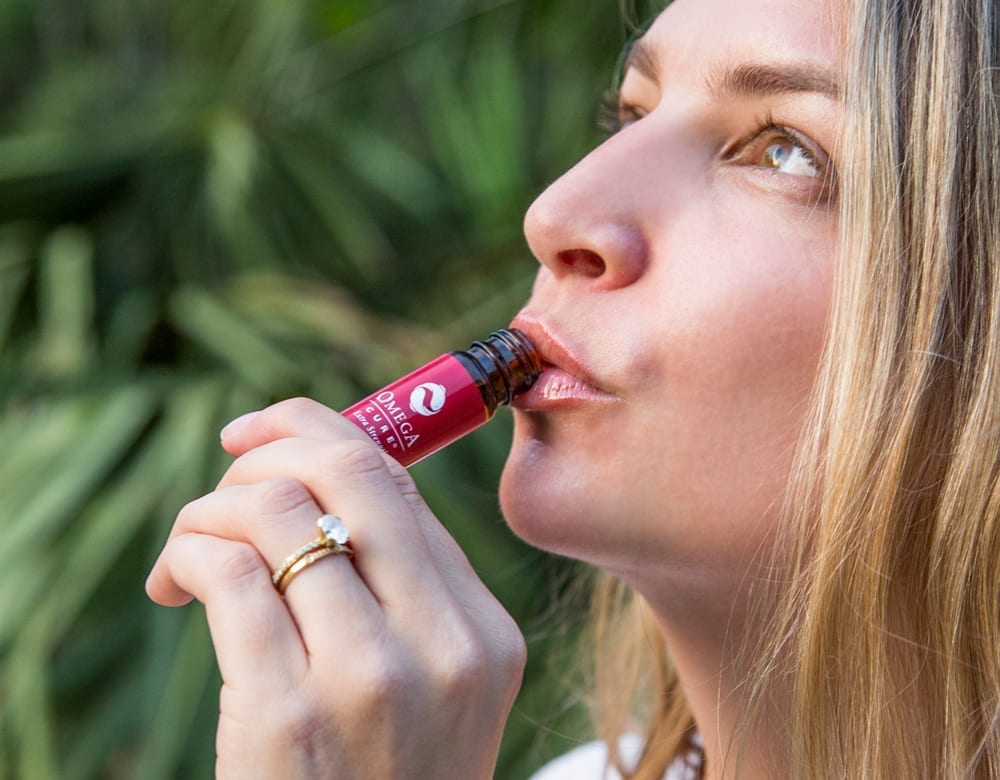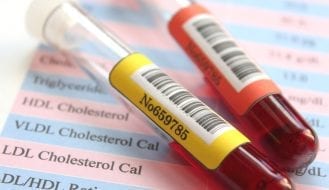Could the Omega-3 Index Be More Important than Cholesterol?
Last year, Bo and I attended the ISSFAL Conference, a biannual event that gathers omega-3 researchers from all over the world to join scientists from American universities like Harvard, Stanford, and Texas A&M. It was a time to share the findings from the latest omega-3 studies and collaborate with leading researchers in the field.
In the midst of all the presenters and information stuffed into the 2018 conference, one important message hit home: The omega-3 index could be a helpful indicator of various health risks, and we should all be paying closer attention to this measurement.
What Is the Omega-3 Index?
Since 2004, scientists have been suggesting that the omega-3 index be used as a way to measure a person’s risk of cardiovascular disease, similarly to how cholesterol levels are used today (1).
The omega-3 index describes the amount of EPA and DHA omega-3 fatty acids in the red blood cells. Simply put, the higher the number, the more EPA and DHA you have in your body.
What Is A Healthy Omega-3 Index?
Having a low omega-3 index number is considered a higher risk factor for developing coronary heart disease and other cardiovascular health issues. How at risk you are depends on where your number falls on the scale:
The Omega-3 Index Scale
- 0 < 4% is considered high risk (“undesirable”)
- 4 – 8% is considered intermediate risk (“intermediate”)
- Above 8% is considered low risk (“desirable”)
Because Americans as a rule consume too few omega-3s from fish or fish oil, it’s no surprise that the majority of Americans have low omega-3 index levels as well. A recent study found that an estimated 95% of Americans had an omega-3 index of 4 or below, putting them in the high risk category (2, 3, 4).
Why Does Japan Have Such a High Average Omega-3 Index?
By global standards, Americans’ omega-3 index levels are abysmal. And it doesn’t have to be this way. For instance, in Japan, the average omega-3 index level is more than double that of the average American. Some surveys show that Japanese men consume over 100 g (approximately 3.5 oz) of fish every day. These radically different dietary habits explain how even those with omega-3 indexes in the lowest 5th percentile of the Japanese population have higher omega-3 index averages than most Americans (5).
The Japanese have the lowest levels of coronary heart disease mortality and atherosclerosis among developed nations — a phenomena that has been largely subscribed to diet. However, even within Japan, one’s omega-3 index matters:
A 10-year study of over 41,000 people found that higher intakes of omega-3s were associated with lower risks of nonfatal coronary events (5). Another study also found that Japanese with omega-3 index levels of 10% had a lower risk of fatal coronary heart disease than those with omega-3 index levels of 8% (6). The study begs the question of whether 8% should be considered the lower limit of a desirable range, rather than the goal.
In Japan, the average omega-3 index is more than double that of the typical American. Studies indicate this is largely due to dietary differences.
Why the Omega-3 Index Matters
We’ve written about the omega-3 dose necessary to achieve measurable benefits before. But in reality, a person’s actual omega-3 intake can be tricky to estimate. Even if you eat at least two servings of fatty fish per week, as the American Heart Association recommends (7), your fish might contain more or less omega-3s depending on the species, the time of year, and how the fish is cooked.
Even taking fish oil supplements isn’t always straightforward, as dose can be impacted by numerous bioavailability factors, as well as genetics, age, diet, gender, medication-use and lifestyle.
Omega-3 Index Testing Could Determine Efficacy
The omega-3 index allows you to really evaluate how much EPA and DHA is integrated into the cells, and how much is available for fundamental metabolic functions. And if you get your omega-3 index measured, you’ll know if your current diet and supplement efforts are sufficient.
This knowledge is especially important given that even health-conscious people are not always self-aware. One survey found that amongst people with omega-3 index levels in the intermediate risk range, some 30% believed they were consuming enough omega-3s (8).
One registered dietitian wrote a compelling story about exactly this experience. She discovered she was in the intermediate range, in spite of her intentions to eat enough fish.
Tips to Improve Your Omega-3 Index
The good news is, even if your omega-3 index is low, you can fix it. Increasing your dietary intake of EPA and DHA by eating fatty fish and taking a fresh fish oil supplement is strongly correlated with increased omega-3 index levels. So, if your omega-3 index level needs improving, you can:
1. Eat More Fatty Fish
Salmon and small oily fish, like sardines and mackerel, are great sources of omega-3s. Smaller fish tend to contain lower levels of mercury than larger predator fish (like marlin, bigeye tuna, and swordfish). When buying fish, it is worth investigating the source of your seafood to learn more about its omega-3 content and sustainability.
2. Commit to Taking an Effective Dose of Full-Spectrum Omega Cure®
Studies show it can take between 1800 – 2000 mg of EPA/DHA daily to move a person’s index by 4 – 5 percentage points (9). For reference, 1800 – 2000 mg of EPA/DHA would be the same as swallowing 6 – 7 regular fish oil capsules. That’s significantly more omega-3 than what most supplement users consume, and this dose discrepancy could well explain why many traditional omega-3 products fail to deliver results. For instance, in a recent survey of 1,200 omega-3 supplement users, only 19% had achieved an omega-3 index of 8% or more.
We typically find that when people consume one tablespoon (or a single vial) of our Omega Cure Extra Strength or Omega Restore™ daily, their omega-3 index levels measure around 11 – 15%. That said, there can be variations between people.
One vial of either Omega Cure Extra Strength or Omega Restore contains 3000 mg of EPA/DHA.
3. Practice These Dietary Changes for 4 Months
Before reassessing your omega-3 index, it’s important to remember that it takes time for the omega-3 fatty acids to be fully-absorbed by the body. Typically, 3 – 4 months should do the trick.
4. Reduce Consumption of Omega-6s
One cannot talk about omega-3s without discussing their fatty acid counterpart — the pro-inflammatory omega-6s. Omega-6s, which are found in vegetable oils and most processed foods we eat, make up a large part of the Western diet. Scientists widely believe that the excessive consumption of omega-6s (and simultaneous depletion of omega-3s from our food) is driving many of the chronic diseases that plague Americans today (10).
Research shows that having a lower omega-6/omega-3 ratio (meaning, you consume a balanced amount of these two fatty acid families) is associated with a reduced risk of cardiovascular disease, cancers, and autoimmune disease, to name a few (11). For this reason, as you work on increasing your omega-3 intake, you can also be more selective about your omega-6 intake and reduce your consumption of processed foods.
The Health Benefits of Regular Omega-3 Use
As mentioned above, the omega-3 index has been suggested as a predictor of the risk of coronary heart disease and other cardiovascular events. Consider the results from the following studies:
- People with low omega-3 index levels were 10 times more likely to die from sudden cardiac death compared to people with higher omega-3 index levels (12).
- People with the highest omega-3 index levels had a 33% reduction in risk of death from any cause compared to the people with the lowest levels. This same study also indicated that the omega-3 index could be a better predictor of death risk than serum cholesterol levels (13).
- Higher omega-3 index levels were associated with lower blood pressure in healthy adults between ages 25 to 41 (14).
The omega-3 index may also be helpful for assessing health risks beyond cardiovascular disease. Studies are currently investigating the relationship between omega-3 index levels and mental health issues, like depression (15, 16, 17), cognitive functioning (18, 19), body weight (20), and eye health issues, like macular degeneration (21), to name just a few.
Could the omega-3 index could be a better predictor of death risk than cholesterol levels? Today, more doctors are adding it to the panel of regular blood tests used to assess overall health.
Implications for Research
More documentation and discussion of omega-3 index levels could also have important implications for future omega-3 research. For some time, there has been confusion about whether fish oil supplements are effective or not. But as some scientists have pointed out, looking at omega-3 index levels could clarify whether study participants are actually getting enough EPA/DHA to make a difference. Plus, measuring omega-3 index levels could help measure compliance rates too.
To date, over 200 published papers have measured the omega-3 index levels of their participants, and we hope that more researchers will follow suit (1).
How to Measure Your Omega-3 Index
Some doctors measure the omega-3 index levels of their patients, just like they do with cholesterol levels. However, if your doctor does not offer this service, several companies provide a quick and easy blood test you can conduct yourself, including OmegaQuant. This company is run by by Dr. William Harris, one of the scientists who initially developed the concept of the omega-3 index.
Bo and I worked with Dr. Harris many years ago to measure the impact of eating one Omega Cookie® daily on the study participants’ omega-3 index levels, and we recently ran into him at ISFFAL. At the conference, we remeasured our omega-3 index and omega-6/omega-3 ratios, and a few weeks later, we got our results in the mail. For the two of us, it was exciting to get another concrete measure of how our daily omega-3 consumption impacted our scores.
Improve Your Life with Fresh, Full-Spectrum Omega-3
Since we started Omega3 Innovations in 2006, many customers have shared with us how Omega Cure has impacted their lives in big and small ways. And as customers have been reporting their omega-3 index levels to us, we’ve been pleased to see their good results.
It reinforces what we’ve always believed: This isn’t just a placebo effect. When people get an effective daily dose of fresh, full-spectrum omega-3 oil, it has a measurable impact on their health.
An Effective Omega-3 Dose, Made Simple
Experience the Omega3 Innovations difference for yourself with the most effective fish oil supplement on the market.
Buy Now
References:
1. About OmegaQuant.
2. Daniells, Stephens. Could Widespread Low Omega-3 Levels Be Putting American Hearts at Risk? Nutra-Ingredients-USA. December 10, 2015.
4. Stark, Ken D et al. Global Survey of the Omega-3 Fatty Acids, Docosahexaenoic Acid and Eicosapentaenoic Acid in the Blood Stream of Healthy Adults. Progress in Lipid Research Volume 63, 2016.
5. Sekikawa, Akira et al. Marine-Derived N-3 Fatty Acids and Atherosclerosis in Japanese, Japanese Americans, and Whites: A Cross-Sectional Study. Journal of the American College of Cardiology Volume 52, Issue 6. August 5, 2008.
6. Harris, William. Redefining Target Omega-3 Index Levels: The Japan Public Health Center Study. Atherosclerosis Volume 272, May 2018.
7. Fish and Omega-3 Fatty Acids. American Heart Association. October 6, 2016.
8. Thuppal, Sowmyanarayanan V et al. Discrepancy between Knowledge and Perceptions of Dietary Omega-3 Fatty Acid Intake Compared with the Omega-3 Index. Nutrients Volume 9, Issue 9. August 24, 2017.
9. Flock, Michael R. et al. Determinants of Erythrocyte Omega‐3 Fatty Acid Content in Response to Fish Oil Supplementation: A Dose–Response Randomized Controlled Trial. Journal of the American Heart Association: Cardiovascular and Cerebrovascular Disease Volume 2, Issue 6. December 2013.
10. Simopoulos, A.P. The Importance of the Omega-6/Omega-3 Fatty Acid Ratio in Cardiovascular Disease and Other Chronic Diseases. Experimental Biology and Medicine (Maywood) Volume 233, Issue 6: 674-88. June 2008.
11. Simopoulos, A. The Importance of the Ratio of Omega-6/Omega-3 Essential Fatty Acids. Biomedicine & Pharmacotherapy Volume 56, Issue 8. October 2002.
12. Von Schacky, Clemens. Omega-3 Index and Sudden Cardiac Death. Nutrients Volume 2, Issue 3. March 2010.
13. GOED. Study Shows Omega-3 Levels Better Predictors of Death Risk Than Serum Cholesterol. EurekAlert! March 15, 2018.
14. Schultz, Hank. Omega-3s Shown to Lower Blood Pressure in Young Adults, Helping to Redefine ‘Healthy Aging.’ Nutra-Ingredients-USA. June 28, 2018.
15. Bigornia, Sherman J et al. The Omega-3 Index Is Inversely Associated with Depressive Symptoms among Individuals with Elevated Oxidative Stress Biomarkers. The Journal of Nutrition Volume 146, Issue 4. April 1, 2016.
16. Parletta, Natalie et al. People with Schizophrenia and Depression Have a Low Omega-3 Index. Prostaglandins, Leukotrienes and Essential Fatty Acids Volume 110. July 2016.
17. Meyer, Barbara J. et al. Baseline Omega-3 Index Correlates with Aggressive and Attention Deficit Disorder Behaviours in Adult Prisoners. PLoS ONE Volume 10, Issue 3. March 20, 2015.
18. Hooper, Claudie et al. Cognitive Changes with Omega-3 Polyunsaturated Fatty Acids in Non-Demented Older Adults with Low Omega-3 Index. Journal of Nutrition, Health and Aging Volume 21, Issue 9. 2017.
19. Lukaschek, Karoline. Cognitive Impairment Is Associated with a Low Omega-3 Index in the Elderly: Results from the KORA-Age Study. Dementia and Geriatric Cognitive Disorders Volume 42. 2016.
20. Albert, Benjamin B et al. Higher Omega-3 Index Is Associated with Increased Insulin Sensitivity and More Favourable Metabolic Profile in Middle-Aged Overweight Men. Scientific Reports Volume 4. October 21, 2015.
21. Merle, Benedicte et al. Circulating Omega-3 Fatty Acids and Neovascular Age-Related Macular Degeneration. Investigative Ophthalmology & Visual Science Volume 55, Issue 3. March 28, 2014.
Recent Posts
-
Dose, Joint Health, Omega-3
Omega-3 & Pain Relief: Finding the Best Strategy
Are you one among the 1 in 5 Americans grappling with chronic pain, as reported by the CDC [1]? If the thought of traditional pain medications and their potential side...3 months ago -
Eye Health, Omega-3
The Startling Link Between Skin Care and Eye Health
Dry eye complaints are on the rise worldwide. Many risk factors – including aging and increased computer use – help explain the increase. But there's another driver few people know...6 months ago -
Heart Health
Does Taking Fish Oil Lower Cholesterol?
Many people believe that incorporating omega-3s into their diet will solve their cholesterol woes. But the truth is much more nuanced; it's not as simple as taking a daily fish...1 year ago -
Immune Health, Sleep
Melatonin & COVID-19: Can This ‘Sleep Hormone’ Help?
It started with a runny nose and a slight cough. But when his 72-year-old wife tested positive for COVID-19, he got concerned. “Is there any research suggesting the supplements we...2 years ago -
Full-Spectrum Fish Oil, Omega-3
Is It Good to Store Fish Oil in the Freezer?
Fish oil is a great source of the omega-3 fatty acids we all need for good health. It’s also highly perishable. Consuming rancid fish oil can have negative health implications....2 years ago -
Omega-3
Our Favorite Omega-3 Fish Oil Benefits
Omega-3 fish oil certainly has a reputation for delivering a plethora of incredible benefits. And it’s true! Omega-3 fatty acids have been studied for a broad range of health conditions....2 years ago












